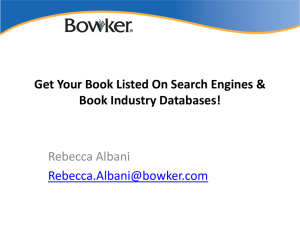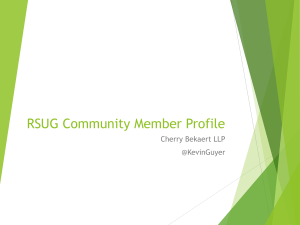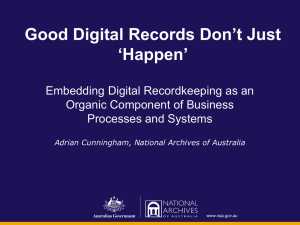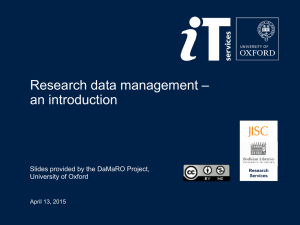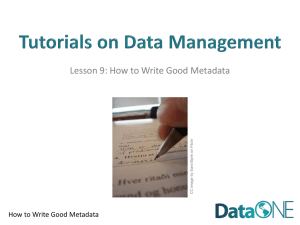Draft DFT Larger Scope
advertisement
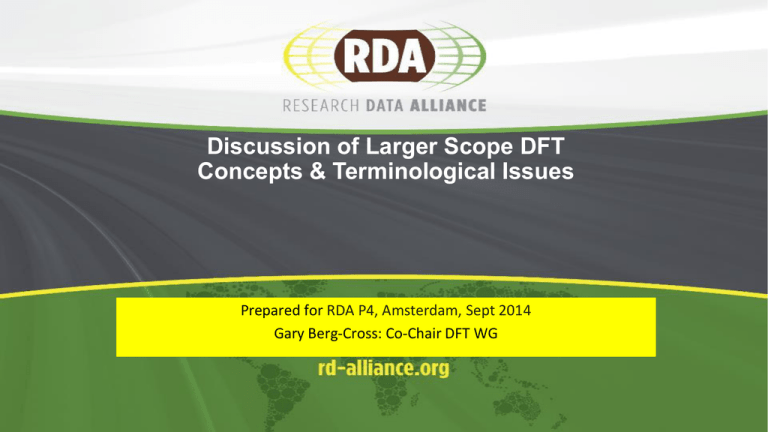
Discussion of Larger Scope DFT Concepts & Terminological Issues Prepared for RDA P4, Amsterdam, Sept 2014 Gary Berg-Cross: Co-Chair DFT WG Topical Outline –is there more to define and richer ways to define it? • Broader View of Data Processes • Boarder WG and Data Concept View Operational • Automated policy driven definitions – example goal • To identify typical application scenarios for policies such as replication, preservation etc. Organizational • Selective examples from metadata • Is Web view of data important to include? • Better Vocabulary Development Procedural • • Data curation registration Aggregations • Recap from P2 • Taxonomies, relations, attributes Unclassified Vocabulary can be Built out in Stages –adapted example from P2 RDA Scope…. 18 months + WG Scope 9-12 months P4-P5? Core 6-9 months P3-P4? Starter Set On 3 months P2 One View of DFT Scope from Process View Policy defines this? 1. What elements are in a PID record 2. How to point to a metadata record 3. What is in a metadata record at registration 4. What is replication with identical vs. different bit-streams that may store additional attributes We have policy for a minimum metadata record? The rest of data management and the lifecycle? Other WGs….. Other Basic Terms -Data Citation as Example • Term Data Citation • Definition Data Citation is the practice of providing a citation to data in a similar way that researchers routinely include a bibliographic reference to published resources. • Examples References [[References::Australian National Data Service [ANDS], [2011], Van Leunen, [1992] • Other sources: quoted from http://www.force11.org/node/4770, cited there as 'adapted from https://www.jstage.jst.go.jp/article/dsj/12/0/12_OSOM13-043/_pdf']] • Related Term: Citable Data is a type of referable data that has undergone quality assessment and can be referred to as citations in publications and as part of Research Objects. Data Citation A citation is a formal structured reference to another scholarly published or unpublished work. In traditional print publishing, a “bibliographic citation” refers to a formal structured reference to another scholarly published or unpublished work. Typically, in-text citation pointers to these structured references are either marked off with parentheses or brackets, such as “(Author, Year),” or indicated by superscript or square-bracketed numerals although in some research domains footnotes are used. Such citations of a single work may occur several times throughout the text. The full bibliographic reference to the work appears in the bibliography or reference list, often following the end of the main text, and is called a “reference” or “bibliographic reference.” Traditional print citations include “pinpointing” information, typically in the form of a page range that identifies which part of the cited work is being referenced. Contextual metadata extraction policies Practical Policy WG area examples • Contextual metadata extraction • Data access control The creation of provenance and descriptive metadata defines a context for interpreting the relevance of files in a collection. Depending upon the data source, there are multiple ways to provide metadata: • Data backup • Data format control • Data retention • Disposition • Integrity (including replication) • Notification.. Extract metadata This policy area focuses on metadata associated with files and collections. • A start on minimal MD? • Key processes across the data lifecycle? Attribute_name Attribute_value Attribute_unit Source_file Source_collection • Extract metadata from an associated document. An example is the medical imaging format DICOM. • Extract metadata from a structured document which includes internal metadata. • Examples are FITS for astronomy, netCDF, and HDF. • Extract metadata by parsing patterns within the text within a document. • Identify a feature present within a file and label the file with the location of the feature that is present within the file. Data LifeCycle define all stages in the existence of digital data from creation to destruction and chained operations Workflows with LC Core definitions then might include…. • Curation : The activity of, managing and promoting the use of data from its point of creation, to ensure it is fit for contemporary purpose, and available for discovery and re-use. • For dynamic datasets this may mean continuous enrichment or updating to keep it fit for purpose. • Higher levels of Curation will also involve maintaining links with annotation and with other published materials. • Archiving : A curation activity which ensures that data is properly selected, stored, can be accessed and that its logical and physical integrity is maintained over time, including security and authenticity. • Preservation : An activity within archiving in which specific items of data/collections are maintained over time so that they can still be accessed and understood through changes in technology. • Interoperability: The ability of a system to accept and send services and to use the services so exchanged to enable them to operate useful. ISO TC204, document N271) Process Infrastructure Uses Transformed Data Data Process Produces Modifies The Basic 4 Part Model (should also note Actors like User as needed) Standardized relations Registry Uses Registered Data Raw Data Registration Process Produces Modifies Illustrating the Basic 4 Part Model Representation Object = Process Infrastructure Uses Information Object Data Object Process Produces Modifies Data Transformed to Information (Note, for now our detailed Processes are what Practical Policy has identified) Notional Core Diagram Reflecting Data Lifecycle and RDA WGs Metadata Types PIT WG Curation Types? Provenance Types? PID Types Uses Raw Data DTR WG Initial Process & Registration Type Registries Modifies Uses ? Archives….. Metadata Registries MDSD WG User/ manager Citation? Data Repositories Referable Data… Collection repositories Data & Metadata Management Practical Policies : Divided by Policy Types such as “Manage data PP WG sets in a repository” Curation/Provenance policies….. Manage Data Sets within the Data Lifecycle Data Types Data Repositories Any of these concepts might be defined as part of DFT Digital Object/Data Management replication of digital objects DO Naming & descriptive metadata DO arrangement DO provenance metadata DO representation & administrative metadata DO retention, disposition, integrity DO access controls Practical Policies: Manage data sets in a repository User/ manager Metadata Catalogs within the Data Lifecycle Data Repositories Metadata Registries/ Directories/Catalogs Metadata Types Metadata Management reserved vocabularies metadata organization in tables metadata properties (creation date, access control, ownership). metadata schema User/ manager Practical Policies: Manage Metadata Catalog Data Repository Metadata Repository Building Data Collections Collection Repositories Data Citation etc… Digital Object/Collection Management Generate PID for digital collection object Collection Naming & descriptive metadata including composition & arrangement Collection representation & administrative metadata Collection provenance metadata including data source for collection Collection access controls Practical Policies: Collection Building and Management User/ manager Terminological Issues Community discussion and Better Definitions 5 steps vocabulary process from scope & requirements to tool building and population to: 3. Focused Vocabulary Design Process and Community Agreement (at and after 3rd Plenary) 4. Refinement & Maintenance (ongoing) 5. Draft Vocabulary Publication and Review (4th Plenary) Still Relevant From P2 - Vocabulary Analysis Process • Identify concepts and concept relations implied by collected terms; • Analyze and model concept systems on the basis of identified concepts and concept relations that are used to understand a term and its referent; • Establishing representations of concept systems through concept diagrams; • Craft concept-oriented definitions as a concept base; • Test arrangement in taxonomical class hierarchy(s) • Add essential Properties/Attributes/slots to distinguish related concepts • Link concepts via Relations…..etc. • Associate a designated vocabulary term to each concept (in one or more languages); and, • Document the vocabulary in an agreed upon form, • perhaps starting as a structured glossary and support concept models Adapted liberally from ISO TC 37 Standards Basic Principles of Terminology Simple Vocab Entry Example from P2 illustrates taxonomy & other relations, attributes etc. • Data Object • Type of: Abstract Object (Taxonomy) • Sub-types: digital object,…… • Definition: n computer science, an object is any entity that can be manipulated by the commands of a programming language, such as a value, variable, function, or data structure. (With the later introduction of object oriented programming the same word, "object", refers to a particular instance of a class) • http://en.wikipedia.org/wiki/Data_object • Definition 2: a Data Object is a dataset • • • • Equivalent terms (other languages) ... Attributes….metadata record with data object name, local ID, PID, representation info, checksum….. Relations a data element isPartof Data Object…. Examples/Instances include: repository metadata, data models, databases, tables, views, files, entities, columns, data elements, and attributes. • (Source http://www.indiana.edu/~dss/Services/Naming/nvgglossary.html) Backup Slides Vocabulary Design Process & Vocabulary Qualities • Both analysis and design may employ conceptual modeling to capture the essential meaning and structure of the descriptions of the vocabulary. • The product of this is some form of conceptual model. • Desired Qualities 1. Adequate capture of content intuitions, expressed by domain experts, 1. 2. 3. 4. in an understandable forms includes details on constraining descriptions Uses well defined relations, taxonomic and others Illustrate with examples 2. Rigorous – stands up to rational analysis 3. Minimally redundant - no unintended synonyms Scope Terms from Model Papers Placed In Tool Overview of Term Development Term Definition Tool prototyped and developed at Rechenzentrum Garching (RZG) der Max-PlanckGesellschaft Starter areas and items : Persistent Identifiers (PIDs and types) Digital Object - Data Object Collection - Data Set - Aggregation Repository (Registries and related Policies) Digital Object A digital object is composed of structured sequence of bits/bytes. As an object it is named. This bit sequence can be identified & accessed by a unique and persistent identifier or by use of referencing attributes describing its properties. Getting Defs organized for review Analysis and Revision Process Conceptual Spaces property contains_a attribute data stream is_equal has_a PID record metadata record has_a bit stream has_a is_a data object has_a digital object has_many instance of a bit stream is_a is_a is_a informational object is_part_of Refinements aggregation is_a is_equal collection is_equal Peter’s Original service object data set corpus • Digital Object (aka Digital Entity) is composed of structured sequence of bits/bytes. As an object it is named. This bit sequence can be identified & accessed by a unique and persistent identifier or by use of referencing attributes describing its properties. • Note Digital Entity definition from X.1255 ITU standard “machine-independent data structure consisting of one or more elements in digital form that can be parsed by different information systems; the structure helps to enable interoperability among diverse information systems in the Internet.” • Metadata is a type of data object that that contains attributes describing properties of an associated data or digital object. It may contain as key the persistent identifier of that associated object. The association between a data object and metadata is that the content of the metadata describes the data object. Metadata may serve different purposes, such as helping people to find data of relevance - discovery (Michener 2006) or to bring data together – federation. • A list of used include: • Discovery, Access, Selection, Licensing, authorization, Quality, suitability and Provenance, reproducibility. • Data properties, both internal and external, are types of metadata as is transactional information about data. • Ref; Michener, W.K. 2006 • Data Object is a type of digital object that included the named bits of a digital object but also has representation object allowing processing of its information content. • Information that maps a Data Object into more meaningful concepts" (OAIS) — makes humanly-perceptible properties happen • Examples: file format, encoding scheme, data format, encoding scheme, data type • Representation Object provide some context for a data object. It contains provenance, description (e.g. format, encoding scheme, algorithm-Brown, 2008), structural, and administrative information about the object. This is a form of metadata. • Brown, A. (2008). White paper: Representation information registries. Retrieved June19, 2009, from http://www.planets-project.eu/docs/reports/Planets_PC3-D7_RepInformationRegistries.pdf • Service Object (Code Object) is a type of digital object containing executable code, considered as a unit. • Note: Under specific circumstances a service object can be viewed as a data object. • Information Object is a type of Data Object which includes the object’s metadata in the Object. • OAIS example, a digital image in TIFF format can only be rendered as an image using software which has been designed to interpret the bitstream in accordance with the TIFF format specification. In other words, the logical Information Object (the image) can only be derived from the physical Data Object (the bitstream) via a process of interpretation. OAIS uses the term Representation Information to describe the knowledge base required for this interpretation. • Active Data denotes virtual units of data objects that are created dynamically by executable code. • Active data may be viewed as a product from executing the workflow. It may thus also be called a "dynamic data object" • Workflow object A Text file listing the chained operations. (too specific to RENCI) 9. Aggregations • Digital Object Aggregation (aka aggregation) is a structured bundle of distinct data/digital objects. • Digital Collection is a type of aggregation. It is also a Digital Object with a PID to be referable and metadata describing at a minimum its aggregation properties. • Gappy Data is an attribute of data collections or sets indicates that it is incomplete at its time of registration and which is completed at unpredictable moments. • Note: Eudat has a definition that might be used. • Active Collection is a type of collection that is being generated dynamically by executable code and results in what some call a dynamic data object. • Data/Digital Sets is a type of managed data collection. It is the basic unit of managed data and has a persistent identifier and metadata. • Alternative Dataset: A collection of data, published or curated by a single agent, and available for access or download in one or more formats. • Compound Data Object/digital objects are bounded aggregations of resources and their relationships • Data Catalog is a curated collection of metadata about datasets. 1 Basic Digital & Data Concepts data is inherently collective so one could be saying data collection as well as data • Digital Data refers to a structured sequence of bits/bytes that represents information content. In many contexts digital data and data are used interchangeably implying both the bits and the content. • Real-Time Data is data/data collection which is produced in its own schedule & has a tight time relation to the processes that create it and that require immediate actions. Timeliness such as real time is an attribute of data. • Dynamic Data is a type of data which is changing frequently and asynchronously. • Note1: EUDAT has defined DD since it occurs in many data creation situations and needs special treatment. • Note2: Dynamic data has also been used in the context of Workflow- workflow that is executed a "dynamic data object", or you can call the results from executing the workflow a "dynamic data object" • Referable Data is a type of data (digital or not) that is persistently stored and which is referred to by a persistent identifier. Digital data may be accesses by the identifier. Some data objects references may access a service on the object (OAI-ORE). • Citable Data is a type of referable data that has undergone quality assessment and can be referred to as citations in publications. More Aggregation Types • Data Container is a type of data structure used to store data collections for particular uses. • File is a named and ordered sequence of bytes that is known by an operating system. A file can be zero or more bytes and has one file format, access permissions, and usually file system statistics such as size and last modification date. • Corpuse (Corpus)is a type of collection that has a meaningful value to a researcher. It may or may not be digitally represented. • Data Container is a type of data structure used to store data collections for particular uses. Data Replication In Repository Data Sources Data DataSources Sources Original MetaData reserved vocabularies Data Repository Associated Metadata Repositories Metadata Management metadata organization in tables metadata properties (creation date, access control, ownership). metadata schema User/ manager Practical Policies: Manage Data Replication in Repository Query of Local Data & Metadata Repositories MD Query Processing User/ manager MD Query User/ manager Data Query Metadata Repositories Data Query Processing Practical Policies: Local Query Operations Local Data Repositories Query of Remote Data Repositories vis PID PID Query Processing Data Query User/ manager PID Registry Data Repository Practical Policies: Remote (Repository) PID Query



